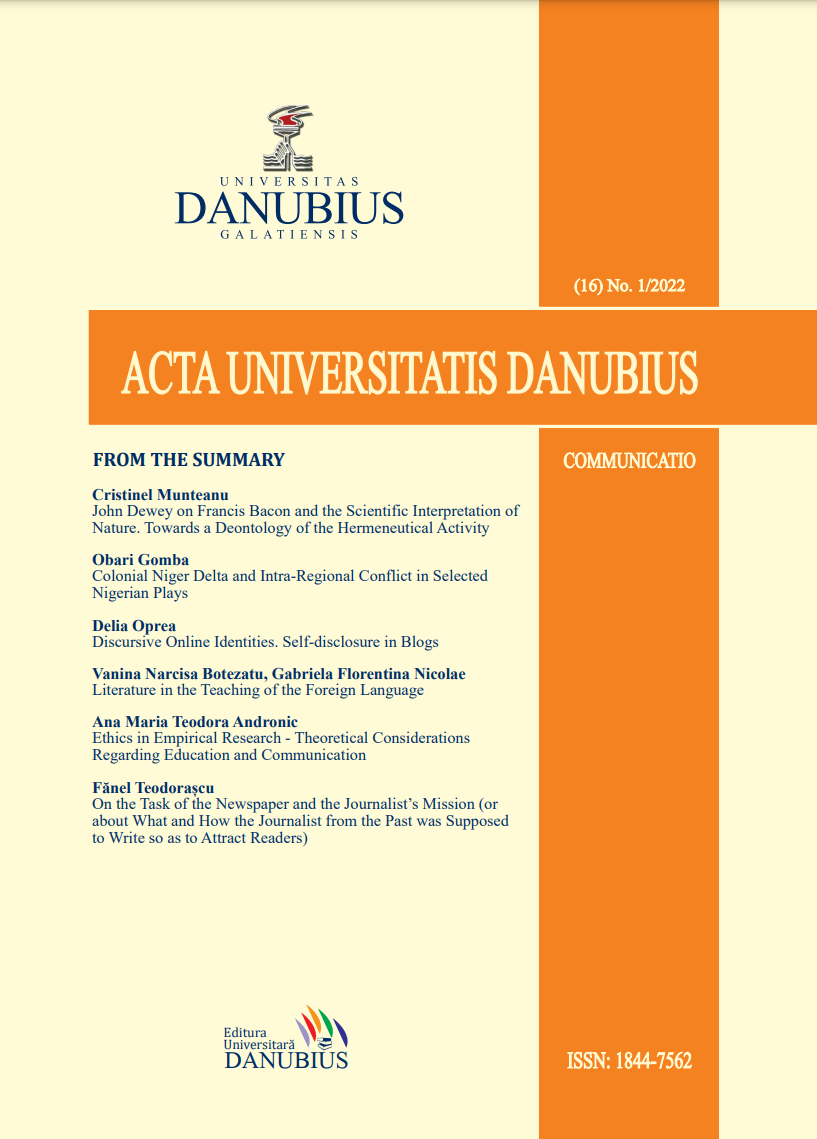Literature in the Teaching of the Foreign Language
Keywords:
mythology; literature; myth; returns; recontextualisationAbstract
This article presents the importance of using the literary text as a didactic tool for teaching a foreign language. We will present the advantages that literary texts offer, as well as the selection criteria in choosing the most appropriate texts, because reading literary texts has a positive impact on the development of discursive skill. At the same time, it offers a series of reflections on the relationship between literature and teaching foreign languages, as well as the fact that the introduction of literature in didactics of foreign languages must take into account the teaching methods, needs and level of learning of students. The example presented can serve as a model, so that the learner can assimilate, in addition to the linguistic forms, the literary forms of the target culture, as the literary text helps to build a vocabulary that allows the use of the language in different contexts and promotes a more accurate knowledge of that reality.
References
*** Internet Archive, [Recuperato da https://ia601502.us.archive.org/15/items/rigoni-stern-il-sergente-nella-neve-ritorno-sul-don/Rigoni%20Stern_Il%20sergente%20nella%20neve%20-%20Ritorno%20sul%20Don.pdf?cv=1]
Acquaroni, R. (2007). Las palabras que no se lleva el viento: literatura y enseñanza de español como LE/L2, Didáctica español Santillana Universidad de Salamanca, Madrid.
Aventín, A. (2008). Del contexto al texto: El texto literario en ELE. Reflexiones y propuesta [Recuperato da http://www.educacion.es/redele/Biblioteca2008/AlejandraAventin.sht]
Balboni, P. (2006). Insegnare la letteratura italiana a stranieri, Perugia, Guerra Edizioni, pp. 1-128.
Balboni, P. (2002). Le sfide di Babele. Insegnare le lingue nelle società̀ complesse, Torino, Utet Libreria.
Bertelli, C. (2021). La letteratura nella classe di Lingua, Modulo del Master Itals, Venezia.
Bredella, L. (2004). “Literary texts and intercultural understanding,” In M. Byram (Ed.), Routledge Encyclopedia of Language Teaching and Learning. London and New York: Routledge, pp. 382–387.
Gilroy, M., & Parkinson, B. (1996). «Teaching literature in a foreign language». Language Teaching, Vol. 29, número 4, pp. 213-225.
Hişmanoğlu, M. (2005). “Teaching English Through Literature”, Journal of Language and Linguistic Studies, vol.1, n.1, April 2005.
Juárez, P. (1998). “La enseñanza de la literatura en los cursos de lengua y civilización para extranjeros” en A. Celis y J.R. Heredia (coords.). Lengua y cultura en la enseñanza del español a extranjeros: Actas del VII Congreso de ASELE. Cuenca: Servicio de Publicaciones de la Universidad de Castilla-La Mancha: 277-283.
Khatib, M. & Rezai, S. & Derakhshan, A. (2011). “Literature in the EFL/ESL classroom”, English Language Teaching, 4 (1), pp. 201-208.
Kramsch, C. (1993). Context and Culture in Language Teaching, Oxford, Oxford University Press.
Ocasar, J. L. (2003). “Funciones de la literatura en la enseñanza de segundas lenguas”, en Boletín de ASELE, mayo 2003: 17-32.
Raccis, G. Mario Rigoni Stern, “Il sergente nella neve”: riassunto della trama, Weschool [Recuperato da https://library.weschool.com/lezione/il-sergente-nella-neve-riassunto-rigoni-stern-neorealismo-letteratura-13006.html]
Downloads
Published
How to Cite
Issue
Section
License
Copyright (c) 2022 Vanina Narcisa Botezatu, Gabriela Florentina Nicolae

This work is licensed under a Creative Commons Attribution-NonCommercial 4.0 International License.
The author fully assumes the content originality and the holograph signature makes him responsible in case of trial.


